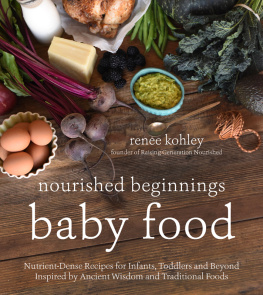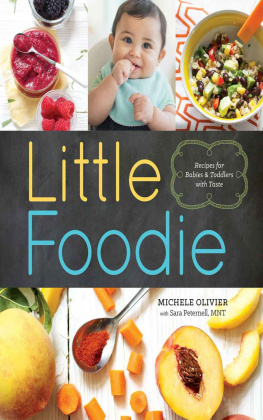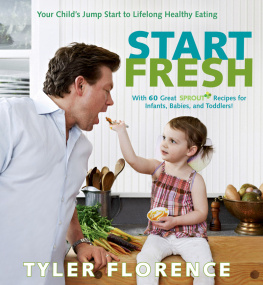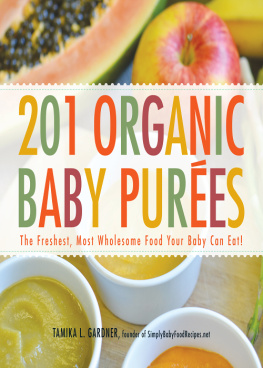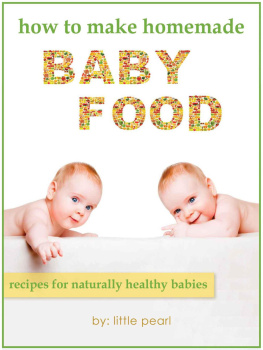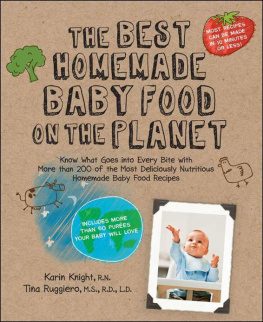





THIS BOOK IS DEDICATED TO
MY FAMILY :
My children,
Miles, Hayden, and Dorothy;
my wife, Tolan;
and my two best friends,
Jake Bacon and
the new baby, Frank Jr.
CONTENTS
STAGE 1 (4 - 6 MONTHS)
SINGLE-INGREDIENT PUREES
STAGE 2 (6 - 8 MONTHS)
FLAVOR COMBOS
STAGE 3 (9 - 12 MONTHS)
FOODS WITH TEXTURE
STAGE 4 (12 MONTHS AND BEYOND)
EVERYONE TO THE TABLE

Foreword

One balmy California evening not long ago, Tyler Florence and I savored a scrumptious dinner together with our families and friends. I had recently finished writing Feeding Baby Green, a safe, simple program for helping kids develop the ability to recognize and enjoy healthy amounts of good food (what we call Nutritional Intelligence), and our conversation naturally moved to the way we as a nation are feeding ourselves and especially our children. Sadly, we all agreed there was tremendous room for improvement, as evidenced by rising rates of obesity and a general unwillingness to try new things among many of the children we meet each day.
As a pediatrician I have come to understand that great food is central to great health and that sharing meals is pivotal to strengthening our connections as family. So you can imagine my excitement as Tyler shared the sights, sounds, textures, and tastes of his culinary visiona celebration of real food that families could enjoy together. The conversation around that table was electric as ideas sparked to and fro.
For too long parents have been hampered by a sense of fear when it comes to feeding their babies. Fear of allergies, fear of not being able to provide safe, nutritious meals without a baby-food jar, and fear that, even if they could, it would be unpleasant, hard work.
In 2008, the American Academy of Pediatrics reassured us that there is no convincing evidence that delaying even items such as fish, eggs, and foods containing peanuts beyond 4 to 6 months lessens the incidence of allergies in children. In 2011, Tyler Florence assures us that cooking for our young children can be beautiful, delicious, and fun.
Were living in an exciting time when it comes to feeding our youngest children. Over the last two decades weve learned a lot about how taste preferences develop during the first few years of life, starting even before birth. For instance, we now know that children tend to form lasting preferences for the sources of food, the styles of food, the colors of food, and the tastes of food that they eat and enjoy on a regular basis as they move from stage to stage during those early years.
This early window of opportunity gradually closes as something called neophobiaa physical distrust of unfamiliar foods that often lingers through the grade-school yearstends to set in. Dealing with neophobia is its own adventure, but you can make that transition a lot more rewarding for you both by celebrating a broad variety of foods and flavors during your childs more receptive, exploratory years.
Youre holding such a celebration in your hands. As you thumb through the pages and delight in the mouthwatering photographsand later, as you stand in the kitchen and sample the recipes youve madeyoull find Tylers love of great food contagious. So will your children.
Bon apptit!
ALAN GREENE, MD, FAAP
Attending Pediatrician, Packard Childrens Hospital at Stanford University
Author of Feeding Baby Green
Let every childs first grain be a whole grain. They wont mind, theyll thank us for it.

START
FRESH

from the
VERYSTART
Introduction
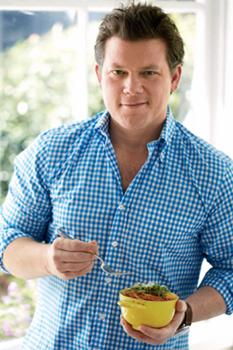
As a chef and father of three, cooking for my children means more than just going through the motions of getting dinner on the table. Its about forging the foundation for a healthy relationship with food that will last for the rest of their lives.
Because my wife and I cook with our children daily, they get a chance to taste everything. Ever since they were old enough to sit up, weve made sure they had a front row seat, banging on pots and pans on the floor of our kitchen while we sliced and stirred and sauted. I always give them a spoonful of whatever Im working on, so they are constantly being exposed to new tastes and textures. Of course they dont love everything, but thats not the point. My objective is to open their minds to the world of real, whole foods and to expose them to a variety of different fresh ingredients and flavors from the very beginning. In other words, to start fresh from the very start.
As parents, we are bombarded by marketing intent on convincing us that we dont know how to feed our children. Food producers would have us believe that the Big 5 (pizza, hot dogs, chicken nuggets, french fries, and burgers) are the only things kids will eat, that chicken nuggets pressed into the shape of a dinosaur are a healthy part of a meal. Its insulting. More importantly, once children get hooked on the taste of processed fat and salt, its a long haul to get them back.
Children begin to make conscious decisions about what they like and dont like from the moment they are born. Infants have a heightened ability to detect sweet, bitter, and sourin fact their sense of taste is 10 times as keen as an adults. So the moment children move away from breast milk or formulausually at around 4 to 6 monthsis the time you can make a gigantic difference in what they consider delicious, the way they eat, and the nutrients they put into their bodies. And all you have to do is cook for them.
Most commercial baby foods put very little thought into the taste of their final product, and their advertising even makes references to winning the battle or test of wills when it comes to feeding children. Even though they cant speak yet, your children are trying to tell you something: They dont like what you are feeding them.
Luckily, nature gave small children the defense system of a gag reflex, and trying to get a child to eat something she simply doesnt like wont be solved by all the choo-choo train or airplane tricks in the world. Hey, weve all been there!
Next page




